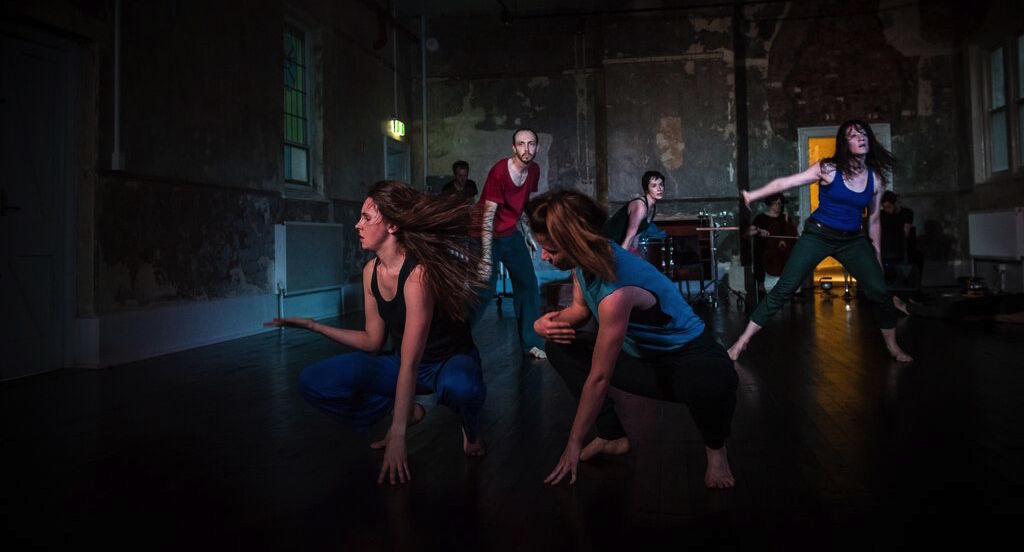As a dance student, I remember being told “make the most of your time here, as you’ll never improve once you graduate.” It was a grim notion, but – although I don’t agree – I’ve since discovered there is an element of truth to it. It’s easy to take for granted the privilege of spending all day in a studio, learning, practicing, exploring and discovering, receiving coaching and feedback, and being encouraged to push past our own limitations.

Helen Duncan at the Creative Behaviours Studio. Photo courtesy of Duncan.
Upon being birthed into “the industry” — fresh, enthusiastic and in peak physical shape — it doesn’t take long for the reality of the world around us to come sharply into focus. There’s very little paid work that is artistically and physically satisfying. We have to navigate the balance of “life” with auditions and classes. We have to work in jobs we hate in order to pay bills and rent and insurance and physio – and somehow still find the time and money to go to class every day. Our fitness starts to drop, and as much as we try to think positively and hang on to our dreams, our enthusiasm for an industry so fickle and unstable starts to wane.
Sound depressing? It sure can be. That’s why it’s so heartening that Creative Behaviours Dance Collective exists.
Launched in 2014 by dancer, creator and director Helen Duncan, a graduate of Western Australian Academy of Performing Arts, the Collective gives professional performers and choreographers the chance to continue their training and practice in between jobs, providing a consistent, structured working environment.
After graduation, Duncan found herself spending countless hours sitting at a computer, applying for grants and searching for opportunities.

Anna Kallstrom performs with Creative Behaviours at the 2015 Common Threads Showcase. Photo courtesy of City of Mandurah.
“I did receive some incredible opportunities, such as the Australia Council’s ArtStart Grant, but most were sporadic, and in my time off I would get frustrated at losing fitness and creative confidence,” Duncan shares.
Recognising it was a common problem amongst her peers, she put the call out for other dancers to meet regularly, train together at no cost and support each other in maintaining physical fitness and mental creative sharpness.
Now in its third year running, Creative Behaviours holds auditions four times a year and runs a stream of six-week projects.
“This gives the dancers the flexibility to commit to a specific timeframe,” explains Duncan. “There is no expectation to continue with the commitment after this time, and we find having this end point really helps dancers to balance their commitment to the program with other professional and personal commitments.”
Participants enjoy regular technique classes, as well as the experience of developing a choreographic work.
“An end goal is always a great motivator, and we do try to wrap each series up with a showing, final performance or video capture,” says Duncan.

Creative Behaviours Dancers. Photo by Pier Carthew.
Rosie Osmond, a graduate of The Space Dance & Arts Centre, says that participating in the program has allowed her to “explore a new area of dance, creative process and theatre. Being able to attend free class every morning in a professional environment is a unique opportunity. The program constantly pushes my artistic boundaries, and the support I have received from the company and choreographers has really enhanced my development and performance practice.”
Dancer and choreographer Elanor Webber agrees, calling the Collective an “incredibly rewarding experience”. She says the structured, supportive environment is “vital to producing a meaningful choreographic practice. The initiative offers this valuable opportunity whilst taking away the pressure of booking and budgeting for space, finding dancers and coordinating timetables. I had the time and space to focus on the creative work, which has been amazing!”
Duncan encourages not just dancers and choreographers to get in touch but also those with an interest in arts administration, producing or marketing. There are also current opportunities for dancers in Western Australia where Creative Behaviours has been commissioned to produce a full-length theatrical experience of wearable art.
“As always, we also keep an eye out for other opportunities, with a number of other potential commissions in the pipeline,” Duncan says. “I would like to encourage choreographers to get in touch with me if they have any projects that they would like to discuss, as we are looking for opportunities to pursue later in the year.”

Caitlin Eames performs with Creative Behaviours at the 2015 Common Threads Showcase. Photo courtesy of City of Mandurah.
So, the future is bright for graduates and those in between contracts. The opportunities to continue to grow and develop do exist. If there’s nothing like Creative Behaviours in your area, consider starting something of your own, as Duncan has done.
“I am reminded I can dance, I can create and I do have a contribution to make,” she says. “It’s a wonderful kind of support to have in what can at times be a tough and heartbreaking industry.”
For more information about Creative Behaviours Collective and to register your interest to get involved, head to www.creativebehaviours.com.au/dance-company.
By Rain Francis of Dance Informa.

















